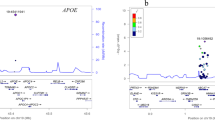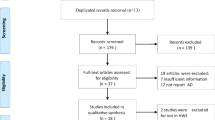Abstract
Although the role of the Cdk5 protein in Alzheimer’s disease (AD) is well recognized, there have been relatively few studies investigating genetic variants in the CDK5 gene in AD. In this study, we assessed the association between five previously described single nucleotide polymorphisms (SNPs) in the CDK5 gene and late onset AD by means of logistic regression and haplotype association analyses. Including all prevalent and incident AD cases, we found a significantly increased risk of AD for carriers of the GG genotype of SNP rs2069442 (OR = 1.79, 95 % CI 1.16–2.79, p = 0.001) in those without APOE*4. When limiting the analysis to incident cases without APOE*4, carriers of the GG genotype showed a 1.9-fold increased risk of AD (95 % CI 1.16–3.10, p = 0.003). Variations in the CDK5 gene can be described in 5 haplotype blocks. In our analysis, the haplotype tagged by the G allele of SNP rs2069442 was significantly associated with AD (p = 0.05). In conclusion, our study suggests that CDK5 may be associated with AD.
Similar content being viewed by others
References
Lee MS, Tsai LH (2003) Cdk5: One of the links between senile plaques and neurofibrillary tangles? J Alzheimers Dis 5(2):127–137
Cruz JC, Tseng HC, Goldman JA, Shih H, Tsai LH (2003) Aberrant Cdk5 activation by P25 triggers pathological events leading to neurodegeneration and neurofibrillary tangles. Neuron 40(3):471–483
Patrick GN, Zukerberg L, Nikolic M, de la Monte S, Dikkes P, Tsai LH (1999) Conversion of P35 to P25 Deregulates Cdk5 Activity and Promotes Neurodegeneration. Nature 402(6762):615–622
Lew J, Winkfein RJ, Paudel HK, Wang JH (1992) Brain Proline-Directed Protein Kinase Is a Neurofilament Kinase Which Displays High Sequence Homology to P34cdc2. J Biol Chem 267(36):25922–25926
Meyerson M, Enders GH, Wu CL, Su LK, Gorka C, Nelson C, Harlow E, Tsai LH (1992) A Family of Human Cdc2- Related Protein Kinases. Embo J 11(8):2909–2917
Li BS, Sun MK, Zhang L, Takahashi S, Ma W, Vinade L, Kulkarni AB, Brady RO, Pant HC (2001) Regulation of Nmda Receptors by Cyclin-Dependent Kinase-5. Proc Natl Acad Sci USA 98(22):12742–12747
Lund ET, McKenna R, Evans DB, Sharma SK, Mathews WR (2001) Characterization of the in Vitro Phosphorylation of Human Tau by Tau Protein Kinase Ii (Cdk5/P20) Using Mass Spectrometry. J Neurochem 76(4):1221–1232
Cheung ZH, Fu AK, Ip NY (2006) Synaptic Roles of Cdk5: Implications in Higher Cognitive Functions and Neurodegenerative Diseases. Neuron 50(1):13–18
Cruz JC, Tsai LH (2004) Cdk5 Deregulation in the Pathogenesis of Alzheimer’s Disease. Trends Mol Med 10(9):452–458
Fischer A, Sananbenesi F, Pang PT, Lu B, Tsai LH (2005) Opposing Roles of Transient and Prolonged Expression of P25 in Synaptic Plasticity and Hippocampus- Dependent Memory. Neuron 48(5):825–838
Lee MS, Kwon YT, Li M, Peng J, Friedlander RM, Tsai LH (2000) Neurotoxicity Induces Cleavage of P35 to P25 by Calpain. Nature 405(6784):360–364
Liu F, Su Y, Li B, Zhou Y, Ryder J, Gonzalez- DeWhitt P, May PC, Ni B (2003) Regulation of Amyloid Precursor Protein (App) Phosphorylation and Processing by P35/Cdk5 and P25/Cdk5. FEBS Lett 547(1–3):193–196
Nakamura S, Kawamoto Y, Nakano S, Ikemoto A, Akiguchi I, Kimura J (1997) Cyclin-Dependent Kinase 5 in Lewy Body-Like Inclusions in Anterior Horn Cells of a Patient with Sporadic Amyotrophic Lateral Sclerosis. Neurology 48(1):267–270
Shelton SB, Johnson GV (2004) Cyclin- Dependent Kinase-5 in Neurodegeneration. J Neurochem 88(6):1313–1326
Han P, Dou F, Li F, Zhang X, Zhang YW, Zheng H, Lipton SA, Xu H, Liao FF (2005) Suppression of Cyclin-Dependent Kinase 5 Activation by Amyloid Precursor Protein: A Novel Excitoprotective Mechanism Involving Modulation of Tau Phosphorylation. J Neurosci 25(50):11542–11552
Bertram L, Mullin K, Blacker D, Tanzi R (2007) Http://www. Alzgene. Org Accessed: March 2007
Rademakers R, Sleegers K, Theuns J, Van den Broeck M, Bel Kacem S, Nilsson LG, Adolfsson R, van Duijn CM, Van Broeckhoven C, Cruts M (2005) Association of Cyclin-Dependent Kinase 5 and Neuronal Activators P35 and P39 Complex in Early-Onset Alzheimer’s Disease. Neurobiol Aging 26(8):1145–1151
Hofman A, Grobbee DE, de Jong PT, van den Ouweland FA (1991) Determinants of Disease and Disability in the Elderly: The Rotterdam Elderly Study. Eur J Epidemiol 7(4):403–422
Vermeer SE, Prins ND, den Heijer T, Hofman A, Koudstaal PJ, Breteler MM (2003) Silent Brain Infarcts and the Risk of Dementia and Cognitive Decline. N Engl J Med 348(13):1215–1222
Barendregt JJ, Ott A (2005) Consistency of Epidemiologic Estimates. Eur J Epidemiol 20(10):827–832
Folstein MF, Folstein SE, McHugh PR (1975) “Mini-Mental State”. A Practical Method for Grading the Cognitive State of Patients for the Clinician. J Psychiatr Res 12(3):189–198
Copeland JR, Kelleher MJ, Kellett JM, Gourlay AJ, Gurland BJ, Fleiss JL, Sharpe L (1976) A Semi-Structured Clinical Interview for the Assessment of Diagnosis and Mental State in the Elderly: The Geriatric Mental State Schedule. I. Development and Reliability. Psychol Med 6(3):439–449
Association AP (1987) Diagnostic and Statistical Manual of Mental Disorders
McKhann G, Drachman D, Folstein M, Katzman R, Price D, Stadlan EM (1984) Clinical Diagnosis of Alzheimer’s Disease: Report of the Nincds-Adrda Work Group under the Auspices of Department of Health and Human Services Task Force on Alzheimer’s Disease. Neurology 34(7):939–944
Miller SA, Dykes DD, Polesky HF (1988) A Simple Salting out Procedure for Extracting DNA from Human Nucleated Cells. Nucleic Acids Res 16(3):1215
Wenham PR, Price WH, Blandell G (1991) Apolipoprotein E Genotyping by One-Stage Pcr. Lancet 337(8750):1158–1159
Barrett JC, Fry B, Maller J, Daly MJ (2005) Haploview: Analysis and Visualization of Ld and Haplotype Maps. Bioinformatics 21(2):263–265
Schaid DJ (2005) Haplo. Stats: Statistical Analysis of Haplotypes with Traits and Covariates When Linkage Phase Is Ambiguous. R Package Version 1. 2. 2. http://mayoresearch. mayo. edu/mayo/ research/biostat/schaid. cfm
Schaid DJ, Rowland CM, Tines DE, Jacobson RM, Poland GA (2002) Score Tests for Association between Traits and Haplotypes When Linkage Phase Is Ambiguous. Am J Hum Genet 70(2):425–434
Guo Q (2006) When good Cdk5 turns bad. Sci Aging Knowledge Environ 2006(5):pe5
Paudel HK, Lew J, Ali Z, Wang JH (1993) Brain Proline-Directed Protein Kinase Phosphorylates Tau on Sites That Are Abnormally Phosphorylated in Tau Associated with Alzheimer’s Paired Helical Filaments. J Biol Chem 268(31):23512–23518
Hanger DP, Hughes K, Woodgett JR, Brion JP, Anderton BH (1992) Glycogen Synthase Kinase-3 Induces Alzheimer’s Disease-Like Phosphorylation of Tau: Generation of Paired Helical Filament Epitopes and Neuronal Localisation of the Kinase. Neurosci Lett 147(1):58–62
Ishiguro K, Takamatsu M, Tomizawa K, Omori A, Takahashi M, Arioka M, Uchida T, Imahori K (1992) Tau Protein Kinase I Converts Normal Tau Protein into A68-Like Component of Paired Helical Filaments. J Biol Chem 267(15):10897–10901
Mandelkow EM, Drewes G, Biernat J, Gustke N, Van Lint J, Vandenheede JR, Mandelkow E (1992) Glycogen synthase kinase-3 and the Alzheimer-like state of microtubule-associated protein tau. FEBS Lett 314(3):315–321
Author information
Authors and Affiliations
Corresponding author
Rights and permissions
About this article
Cite this article
Arias-Vásquez, A., Aulchenko, Y.S., Isaacs, A. et al. Cyclin-dependent kinase 5 is associated with risk for Alzheimer’s disease in a Dutch population-based study. J Neurol 255, 655–662 (2008). https://doi.org/10.1007/s00415-008-0770-5
Received:
Revised:
Accepted:
Published:
Issue Date:
DOI: https://doi.org/10.1007/s00415-008-0770-5




